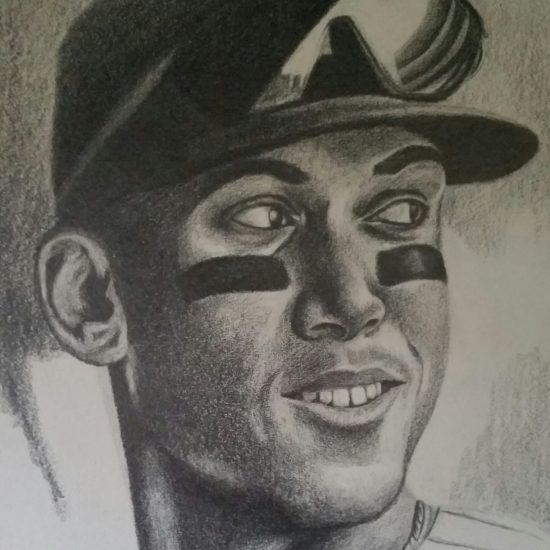This past offseason, Pitcher List introduced Pitch Level Value, or PLV, a new metric that assesses player performance by grading outcomes relative to the quality of the pitch. If you’re new to it, you can read Nick Pollack’s primer on PLV here.
You’ll find the definitions below. Grades are on a 20-80 scale.
Swing Aggression: How much more often a hitter swings at pitches, given the swing likelihoods of the pitches they face.
Strikezone Judgement: The “correctness” of a hitter’s swings and takes, using the likelihood of a pitch being a called strike (for swings) or a ball/HBP (for takes).
Decision Value (DV): Modeled value (runs per 100 pitches) of a hitter’s decision to swing or take, minus the modeled value of the alternative.
Contact Ability: A hitter’s ability to make contact (foul strike or BIP), above the contact expectation for each pitch.
Power: Modeled number of extra bases (xISO on contact) above a pitch’s expectation, for each BBE.
Hitter Performance (HP): Runs added per 100 pitches seen by the hitter (including swing/take decisions), after accounting for pitch quality.
Pitch Level Value (PLV): Estimated value of all pitches, based on the predicted outcome of those pitches (0-10, 5 is league average, PLV is not adjusted for pitch type).
Pitch Level Average (PLA): Value of all pitches (ERA Scale), using IP and the total predicted run value of pitches thrown.
Pitch type PLA: Value of a given pitch type (ERA scale), using total predicted run values and an IP proxy for that pitch type (pitch usage % x Total IP).
(Note: All stats are current through Thursday, 9/21).
As we look ahead to next year (I know, I’m bummed about it ending too) let’s review what we saw from some of this year’s notable rookie position players. We’ve seen some big prospects get called up recently including Evan Carter, Heston Kjerstad, and Pete Crow-Armstrong but we’ll focus on players with at least a 500-pitch sample size to give us a better idea.
Hard to believe that Gunnar Henderson hit .2o1 with a .732 OPS through his first 50 games. One thing that was very noticeable was a huge jump in swing aggression.
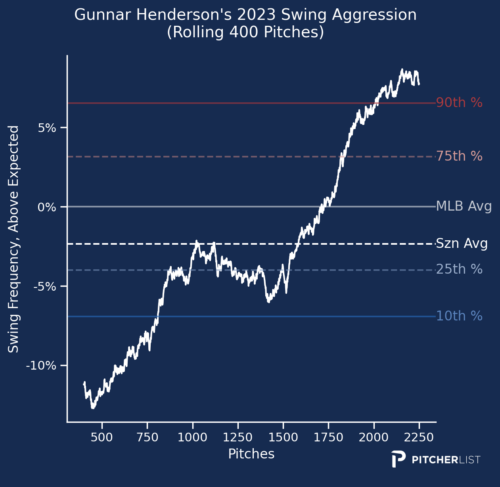
It’s an interesting development because he was originally billed as a more deliberate type of hitter with a patient approach but his walk rates cratered as the season went on. Does that mean anything for fantasy purposes? Probably not, unless you’re in an OBP league; then you might want to bump him down slightly. Otherwise, Henderson’s profile shows excellent power (60) with average contact ability (50) and average swing decisions (50 DV).
Corbin Carroll’s ascension to baseball superstardom went off without a hitch. There might have been some doubts about how his power would play but the fact that he already rates league average in year one is impressive. Combine that with his mind-blowing speed and above-average contact (55) and you have an easy Top 5 pick. Now imagine if he leans into a little more power? I know that’s greedy, but I can’t help myself.
Second Base and SS
Anthony Volpe is interesting. His rookie season might be viewed as a disappointment given his ugly slash. But 21 home runs and 24 stolen bases are nothing to sneeze at; if his rate stats improve, then he could be on the verge of being a real difference-maker. He showed some progress this year in terms of making better-quality swing decisions; however, his contact ability is still a weakness.
Speaking of suspect contact ability, Matt McLain was starting to show some swing-and-miss problems before he landed on the IL with an oblique strain. His .290/.357/.507 slash looks great, especially compared to Volpe but I’m a little worried by the trend we saw in his contact ability.
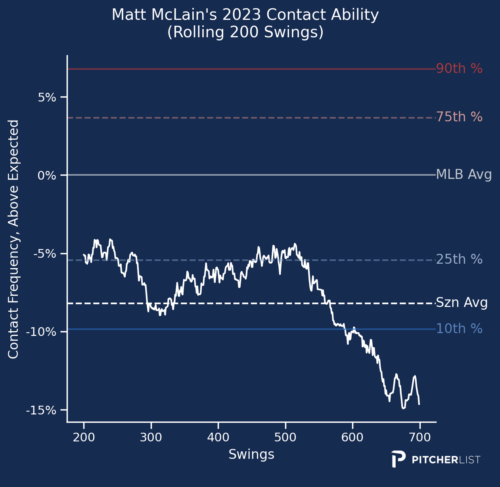
Zack Gelof has showcased tremendous power (60) but his contact ability (30) is a little worrisome. Still, the PLV machine has loved Gelof’s performance thus far.
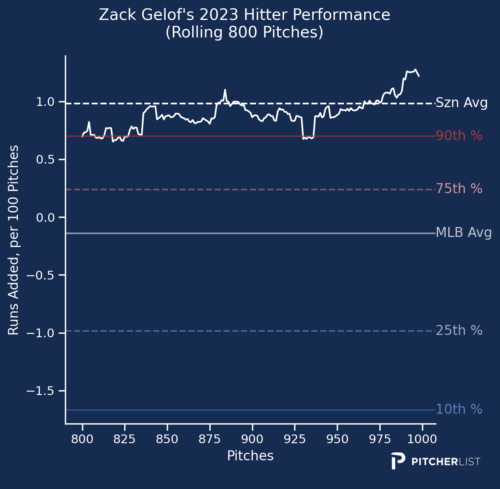
Davis Schneider broke history with some of his early results and has showcased some elite-level swings and takes. I think he’s a little similar to Max Muncy given his power (70) and DV (70). But Schneider’s contact-ability has really bottomed out; on second thought, maybe Jack Suwinski is a better comp.
Both Twins rookie Edouard Julien and Schneider have showcased elite DV (70) with passive plate tendencies but Julien has shown a little better contact ability (35) albeit with a bit less power (55).
Remember Miguel Vargas? Before getting sent down in July, he showcased a very keen eye at the plate but the results just weren’t there. Maybe he will put it together next year?
Barring some growth in year two, Ezequiel Tovar looks like a pretty tough sell. He’s hit second in the order a bunch this season but I think his extremely aggressive approach might make him a better fit near the bottom of the order. That along with average power and slightly below-average contact ability make him hard to get excited about.
Outfield
It’s hard to avoid feeling jaded about Rockies prospects, or anything Rockies-related. However, Nolan Jones gives us something to be excited about next year: excellent power (65) and only slightly below-average contact (45). His contact ability trended up as the season went along too.
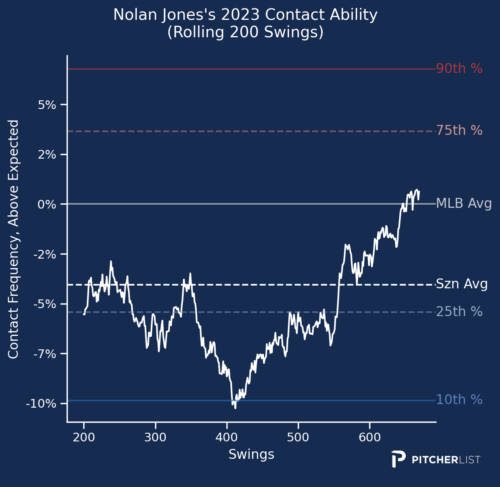
The other fun thing is that he showed near even home (.378 wOBA) and road (.381 wOBA) splits. And, hey, he wasn’t bad against LHP either (.360 wOBA in 118 PA).
No one doubts Jordan Walker’s fantastic raw power, but it didn’t quite translate in year one. Still, the Georgia native has been percolating of late with a .902 OPS over 18 games in September. Take a look.
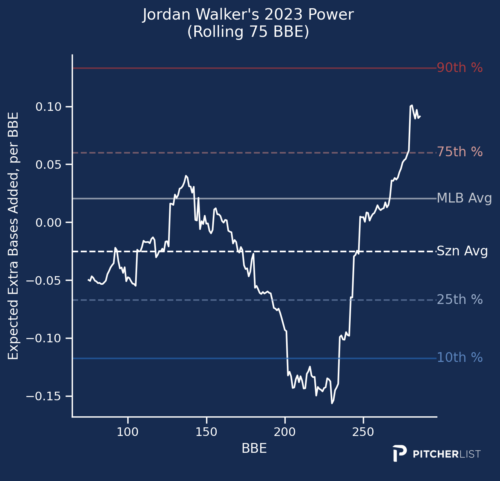
The post-hype sales pitch more or less writes itself, doesn’t it? But for now, Walker’s grades as a whole are more or less average across the board.
Sal Frelick has paid homage to the scouting report by showcasing excellent contact-ability (65) but his below-average power (40) probably caps his upside for fantasy purposes, that is unless he can make do with his wheels. On that note, he’s a perfect seven-for-seven on SB attempts.
James Outman started off gangbusters with a .991 OPS in April but fell off. He’s more or less on the opposite end of the spectrum as Frelick with good power (55) but questionable contact (30); although he’s also shown a penchant for swinging at good pitches to hit (60 DV). Outman’s .670 OPS against LHP this season (148 PA) has relegated to a strict platoon making him more of a daily league bat.
Masataka Yoshida is a bit similar to his outfield mate Alex Verdugo in that he’s shown plus contact ability (60) but below-average power (45). There was some hope at the very beginning of the season that he might have a shot at hitting leadoff, but he hasn’t proven to be that sort of a hitter with a low walk rate and a batter’s eye that’s nothing to write home about (40 SZ Judgement and 40 DV).
Drafted in the 32nd round of the 2016 draft out of Forest Lake High School in Minnesota, Matt Wallner debuted late last season, so he was easy to overlook. However, he’s put together a .850 OPS over 226 PA this season. Wallner’s shown a really sharp eye at the plate (70 SZ Judgement/70 DV) with big power, but it comes with shaky contact-ability (30). That corresponds with what he posted in 68 games at Triple-A St. Paul: A .291/.403/.524 slash with an elevated 28.9% K rate.
First Base
I’ve waxed poetic about Triston Casas at least once this year so I’ll keep it short; his combination of impressive swing decisions (60 DV) and terrific power (65) at 23 years old has him on the cusp of being the next big thing at first base.
Christian Encarnacion-Strand’s impressive power (60) has been muted a little bit by below-average swing decisions (40 DV). Still, there’s a pretty spicy power ceiling lurking that’ll be worth chasing in year two, provided he has a more consistent role.
Spencer Steer’s .813 OPS is good for 11th among qualified rookies. He’s shown only average power but his profile is boosted by a strong plate approach (55 SZ Judgement and 60 DV).
Third Base
Elly De La Cruz will almost certainly be discussed at length this offseason. It’s encouraging that he’s already shown average contact ability and power at 21. I think being a switch-hitter complicates his case a little. I’ve always believed that switch hitters take more time to peak, although admittedly I have no idea if that’s actually true. Anyways, the results were stark: A .328 wOBA vs. RHP and a .225 wOBA vs. LHP. Cruz’s potential goes without saying but whether he can reach his ridiculous ceiling is going to come down to better pitch recognition. Poor swing decisions (35 DV) were definitely a big reason behind his struggles.
Royce Lewis just landed on the IL with a hamstring strain which is brutal timing for him and the Twins as they prepare for the playoffs. The former top prospect leads all qualified rookies with a .920 OPS and the PLV machine loved the results too grading him with a 70 in Hitter Performance.
Before he was sent to the IL with a broken thumb, Josh Jung gave us a lot of things to get excited about including great pop (60) and much-improved contact ability relative to his cup of coffee last year (50). However, Jung’s contact ability is a little odd when you look at his rolling chart.
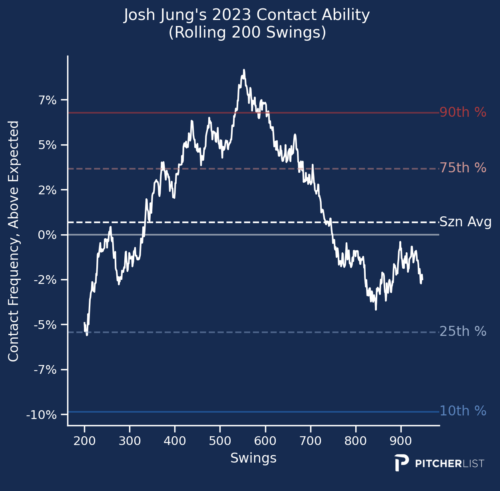
Mark Vientos might be an interesting name to file away for next year. His slash isn’t pretty nor is his PLV profile but he hasn’t really received consistent playing time until relatively recently, and he’s started to get some results. He’s hitting .288 with a .910 OPS through 16 games in September.
Catchers
Yainer Diaz leads rookie backstops with his power (65) and he’s an exceedingly aggressive hitter; only Mickey Moniak and Salvador Perez have a higher swing aggression (500 pitch minimum).
Francisco Alvarez hasn’t shown quite as much power as Díaz but he’s shown a much better eye at the plate (60 SZ Judgement, 55 DV).
Patrick Bailey has showcased above-average pop (55) but playing at Oracle Park I think has probably muted the results; he has just seven home runs in 334 PA.
OK, you got me, technically Gabriel Moreno isn’t a rookie, but I wanted to include him here to give us another catcher to look at. The former Blue Jays prospect is ending the season on a high note hitting .364 with a .942 OPS over his last 15 games. His profile is highlighted by his excellent contact ability (60).
Luis Campusano is, also, like Moreno, not rookie-eligible. Regardless, he’s made the most of his extended audition hitting .312 with a .832 OPS over 47 games. He’s shown even better contact ability than Moreno (65) with slightly below-average power (45). He was a prominent prospect not that long ago, and the early returns in his first real stint give us a glimpse at a player who might potentially shake up a shallow position.
Edit: Say it ain’t so, I forgot Bo! Josh’s younger brother Bo Naylor is finishing the season on a good note hitting .318 with a 1.020 OPS across 15 games in September. He’s shown above-average contact ability (55) while also demonstrating improvements in the quality of his swing decisions. That’s what we like to see.
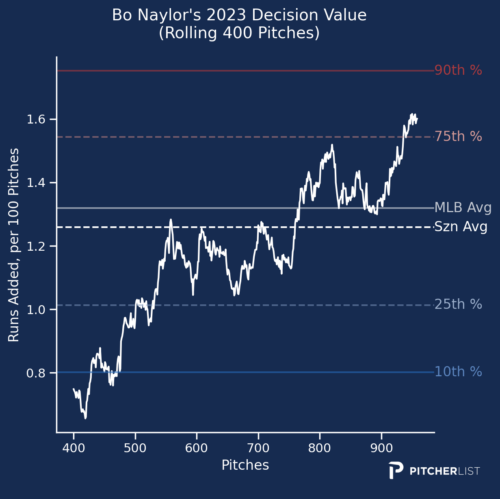
Photo by Frank Jansky/Icon Sportswire | Adapted by Justin Paradis (@JustParaDesigns on Twitter)

